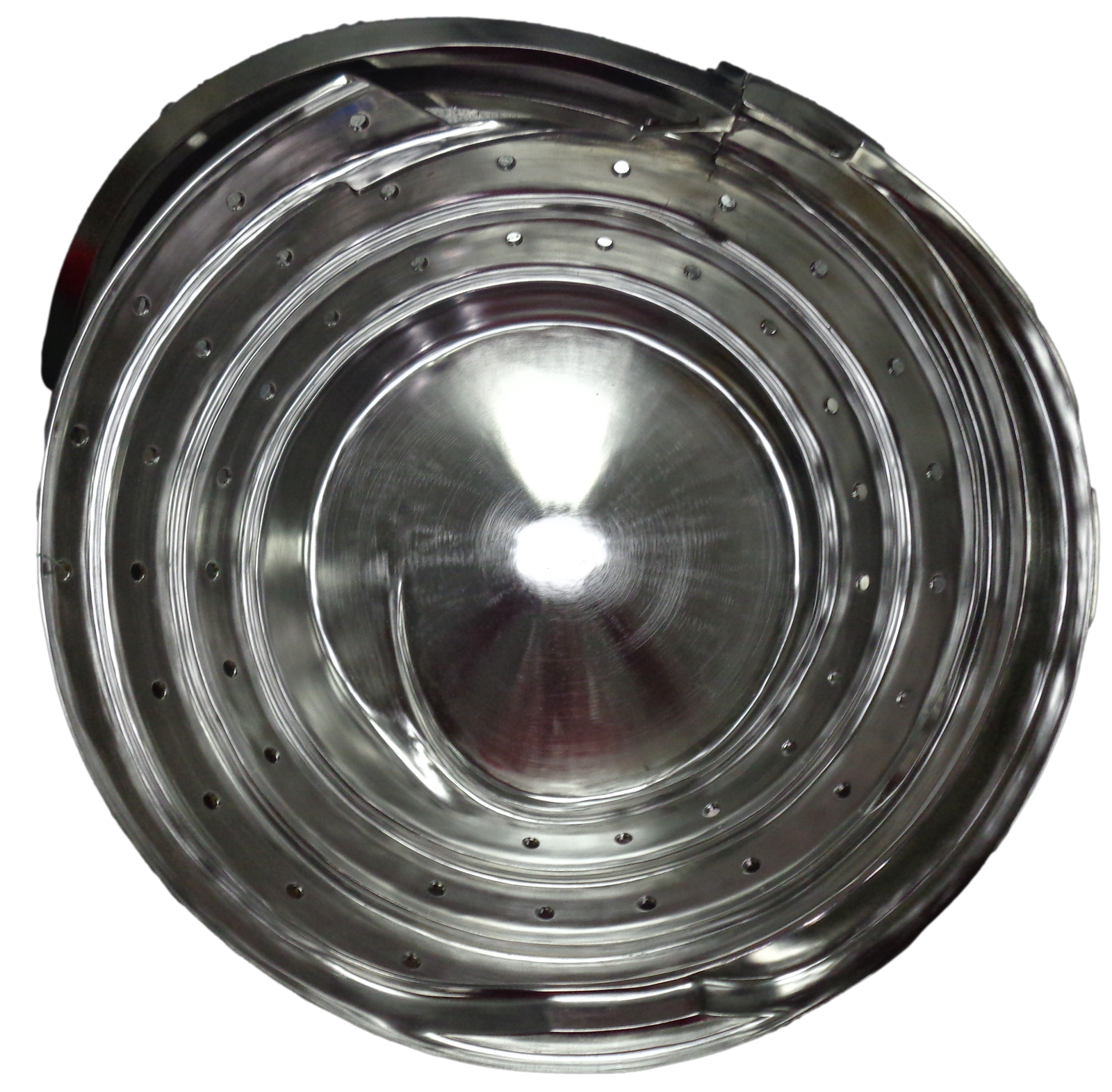Vibratory Feeders and ISO Clean Room Standards

Not all vibratory feeders are created equal and there can be vastly different conceptions of what an "FDA" or "Medical" grade vibratory feeder is from one manufacturer to another.
While the typical idea of a medical grade feeder bowl may be as simple as a bowl made of stainless steel with all joints fully welded and all the welds are ground smooth. However, there is more to it than just a shiny bowl. As discussed in more detail below, ISO standards look at the particulate generation as well as contamination potential. Because of the large swath of regulation variations from ISO 1 to ISO 9, Moorfeed Corporation follows its own internal specifications regarding medical grade feed systems. Just a few standard practices Moorfeed follows that are not industry standard:
- Material Certification, tracking, and isolation
- Virgin abrasives and cutting tools are used during fabrication
- Magna-Flux inspection for equipment that will be electropolished
- No blind holes, even in our stand-offs
These specifications as well as typical, fill and grind welds, polished finish, and stainless fasteners provide a systematic approach to medical grade vibratory feeder fabrication.
ISO cleanroom standards, defined by ISO 14644-1, classify cleanrooms from ISO 1 (cleanest) to ISO 9 (least clean) based on the maximum allowable airborne particle concentration per cubic meter, measured in micrometers (µm). These standards are critical in industries requiring contamination control, such as pharmaceuticals, biotechnology, and semiconductor manufacturing. Below, I explore the correlation between vibratory feeders and ISO cleanroom standards, focusing on their design, application, and compliance in cleanroom environments.
1. Role of Vibratory Feeders in Cleanroom Environments
Vibratory feeders are often integrated into cleanroom processes to automate material handling, ensuring precise and efficient movement of components like syringes, connectors, or electronic parts without human intervention, which reduces contamination risks. Their use is particularly relevant in ISO 4 to ISO 8 cleanrooms, where industries like pharmaceuticals and electronics require controlled environments to prevent particulate contamination. For example:
-
Pharmaceutical Industry: Vibratory bowl feeders handle components like caps, plugs, or medical filters, designed to meet Good Automated Manufacturing Practice (GAMP) standards and comply with ISO 6 to ISO 9 cleanroom requirements.
-
Electronics and Semiconductor Manufacturing: Feeders handle delicate parts like microchips, requiring low particulate emission to align with stricter ISO 4 or ISO 5 standards.
-
Food and Beverage: ISO 7 or ISO 8 cleanrooms may use vibratory feeders for packaging high-value products to ensure contaminant-free processes.
2. Design Considerations for Cleanroom Compatibility
To correlate with ISO cleanroom standards, vibratory feeders must be designed to minimize particle generation and facilitate easy cleaning, aligning with the stringent particle limits of each ISO class (e.g., ISO 7 allows ≤352,000 particles ≥0.5 µm per m³, ISO 4 allows ≤10,000 particles ≥0.1 µm per m³). Key design features include:
-
Materials: Feeders use stainless steel or polymers with smooth, non-porous surfaces to prevent particle accumulation. Welds are ground smooth to eliminate crevices.
-
Coatings: Urethane or other FDA-approved coatings reduce wear and particulate emission, critical for ISO 4 to ISO 6 environments.
-
Low Particulate Emission: Piezo-electric drives, air driven drives, and enclosed drives are used on some cleanroom feeders, these produce minimal particles, making them suitable for ISO 4 environments.
-
Enclosures: Feeders may include dust and noise control enclosures to contain particles, especially in ISO 7 or ISO 8 settings.
-
Tooling Design: Cascade or conical bowl designs with open, cavity-free structures simplify cleaning and reduce particle traps, ideal for pharmaceutical applications.
3. ISO Cleanroom Standards and Feeder Compatibility
The compatibility of vibratory feeders with specific ISO classes depends on the industry and process requirements:
-
ISO 4–5 (Class 100–1,000): Used in semiconductor or nanotechnology industries, these require feeders with ultra-low particulate emission (e.g., piezo-electric drives, hard-plated surfaces). Regular monitoring and validation ensure compliance with strict particle limits (e.g., ISO 4: ≤10,000 particles ≥0.1 µm/m³).
-
ISO 6–7 (Class 1,000–10,000): Common in pharmaceutical and medical device manufacturing, these environments use stainless steel vibratory feeders with GAMP-compliant designs. Particle limits (e.g., ISO 7: ≤352,000 particles ≥0.5 µm/m³) allow for slightly higher tolerance but still require rigorous cleaning protocols.
-
ISO 8 (Class 100,000): Suitable for less critical processes like food packaging or lower-risk medical device assembly, where feeders can operate with standard non-directional airflow and fewer air changes per hour (10–25 ACPH).
-
ISO 9: Essentially room air, rarely used for critical processes but may employ feeders for general manufacturing with minimal contamination control.
4. Compliance with Cleanroom Standards
Vibratory feeders must align with ISO 14644-1 and industry-specific standards like EU GMP Annex 1 or USP 797/800 for pharmaceuticals. Compliance involves:
-
Validation and Testing: Feeders must operate within the cleanroom’s particle count limits, verified through particle count testing every six months for ISO 4–5 or annually for ISO 7–8 if real-time monitoring is in place.
-
Cleaning Protocols: Feeders require regular cleaning with non-shedding materials to prevent contamination, especially in ISO 5–7 environments.
-
Airflow Integration: Feeders must not disrupt laminar or turbulent airflow systems. For example, ISO 4–5 cleanrooms use unidirectional airflow, requiring feeders to be positioned to avoid turbulence.
-
Bioburden Control: In medical device or pharmaceutical settings, feeders must minimize microbial contamination, aligning with EU GMP Annex 1 guidelines, which may include microbial limits not covered by ISO 14644.
5. Challenges and Considerations
-
Particle Generation: Vibratory motion can generate particles through material friction, challenging compliance in stricter ISO classes. Advanced control systems with sensors and feedback loops mitigate this by adjusting vibration amplitude.
-
Maintenance Costs: Maintaining feeders in cleanrooms, especially ISO 4–5, involves significant costs due to rigorous cleaning, validation, and HEPA/ULPA filter maintenance.
-
Industry-Specific Standards: While ISO 14644-1 is universal, pharmaceutical feeders must also comply with GMP or USP standards, which may impose stricter operational requirements (e.g., EU GMP Annex 1 for sterile products).
6. Critical Examination
While sources emphasize compliance with ISO standards, the narrative often assumes vibratory feeders can be universally adapted for cleanrooms. However, practical challenges like vibration-induced particle generation or compatibility with laminar airflow are underexplored. For instance, electromagnetic drives may be less suitable for ISO 4–5 due to higher particulate emissions compared to piezo-electric alternatives, yet this distinction is rarely highlighted.
Conclusion
Vibratory feeders correlate with ISO cleanroom standards through specialized designs that minimize particle generation and align with industry-specific cleanliness requirements. They are most effective in ISO 6–8 cleanrooms for pharmaceuticals, medical devices, and food packaging. Compliance requires careful material selection, cleaning protocols, and integration with cleanroom airflow systems, validated through regular testing. However, challenges like particle generation and maintenance costs highlight the need for tailored solutions based on the specific ISO class and industry standards.
Vibratory Drives
Drive units are an integral part of clean room feeding, we will cover vibratory drives and their impact on clean room standards in a future post.

